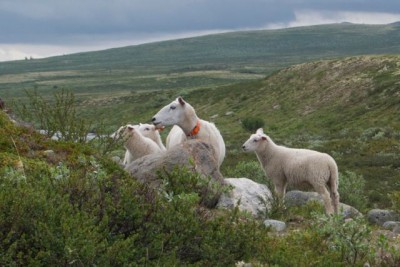Fallout from the accident at the Chernobyl nuclear power plant continues to affect Norwegian farmers 25 years later, as environmental organizations demanded that the government do more to help efforts to secure remaining vulnerable reactors in both Chernobyl and northern Russia.

Emissions of radioactive material from the Ukrainian nuclear facility began on April 26 1986, and soon found their way to Norway after being transported by northerly winds. Traditional farming and grazing areas in Gulbrandsdalen, Valdres and Østerdalen in south-central Norway were particularly affected.
Grazing still affected
Just last year, 200 reindeer and 20,000 sheep had to be taken down from traditional grazing areas and fed alternative foodstuffs before they were sent to slaughter, because their meat could contain levels of radiation that were too high. In 2009, 35 local municipalities saw the partial or complete removal of goats and sheep from outlying grazing areas for several weeks before being slaughtered. Mushrooms in particular have been badly contaminated, and large outbreaks of the vegetable during the autumn can create serious issues for farmers.
Farmers have received state compensation to the tune of NOK 5 (just under USD 1) per animal that must be taken down from open grazing areas and fed with feed since 1987. The total compensation last year amounted to NOK 4.4 million (over USD 800,000). One farmer, Pål Grev, told Norwegian Broadcasting (NRK) that “it is tiring that we still have to struggle with pollution caused by another country.” He added that “when this happened in 1986, I never thought that 25 years later we would still be doing this in the autumn.” He believes that he “will probably still be doing this for another 25 years.”
‘Norway must contribute more to Chernobyl project’
Problems also persist at the Chernobyl facility itself. The so-called “sarcophagus,” which currently covers the plant, was only supposed to last 20 years, and is in need of replacement before a collapse releases yet more radiation. Nils Bøhmer, a nuclear physicist with Norwegian environmental group Bellona, told newspaper Aftenposten that the project to replace the sarcophagus “still lacks NOK 1.6 billion [USD 300 million].” The Norwegian government has thus far contributed with NOK 85 million (USD 16 million) to the fund – a number which Bellona believes is based on out-of-date estimates for the cost of the project from 10 years ago, which have since doubled.
“On the 25th anniversary of the accident, it would be a fitting gesture if Norway doubled its contribution,” Bøhmer told Aftenposten. “We should do it first and foremost out of solidarity with Ukraine. In addition, Norway was one of the surrounding countries hardest hit by the accident. If the Ukraine does not receive a satisfactory security system, we could be hit again.”
In response, a foreign ministry state secretary, Erik Lahnstein, confirmed to Aftenposten that “because it seems the need will be greater than previously expected, we will contribute with an extra effort and give a further NOK 4 million [just over USD 750,000] in this round.” Lahnstein said that they could not give more because “Norway’s main focus is on atomic security for the Kola facility in north Russia,” where the government has “repeatedly encouraged Russian authorities to wind up the old nuclear power station.”
Fears for Russian nuclear plant
Indeed, fears of another nuclear incident that could affect Norway stem mostly from the Kola plant. Estimates by Norwegian meteorologists suggest that Norway would be seriously affected by any accident at Kola. The county mayor of Finnmark in north Norway, Runda Sjåstad of the Labour Party, told NRK that he is “personally very worried” about the former Soviet facility. He noted that “even if it has been improved and received security updates, the expert advice is that it should not continue beyond its actual lifespan.”

The mayor and the county authorities in Finnmark have made their concerns known to their Russian counterparts, but Sjåstad believes that “the economic arguments weigh heaviest” when it comes to the continuation of the plant’s operations. He suggested that those in Norway who support the buying of nuclear power from Russia should consider that “we as a market also influence production at Kola.” Sjåstad is also concerned that the security routines at the plant “do not work.” There are reportedly plans for further new reactors at Kola.
Protest and opposition
Some Russian environmentalists, such as Sergej Zhavoronkin – an earlier leader of Bellona Murmansk who now runs WWF Murmansk – believe that nuclear power is “good, as long as security is taken care of.” Nonetheless, other Russians have spoken out against continued production at Kola, including nuclear physicist Andrej Osharovskij. He told NRK that the “first generation reactor should have been closed a long time ago,” as it “lacks among other things a security seal if there should be a discharge.” He pointed to that the fact that Angela Merkel has closed all of the reactors of a similar age in Germany after the problems experienced by the Japanese in the Fukushima plant incident.
In Norway, environmental organizations Nature and Youth, and Friends of the Earth Norway, were marking the anniversary of the Chernobyl disaster with a protest outside the Parliament. They were calling for, among other things, clearer demands from the Norwegian government to close Kola and more investment in a new sarcophagus for Chernobyl. They will also call on the Norwegian government to lobby internationally for a global agreement against nuclear power which makes clear that “it is not a solution for reducing emissions of dangerous greenhouse gases.”
Join our Reader Response if you’d like to comment on this story.

